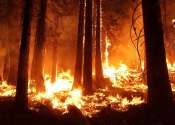Scientists discover forests that may resist climate change
While it's common knowledge that mountaintops are colder than the valleys below, a new University of Vermont (UVM) study is flipping the script on what we know about forests and climate.

While it's common knowledge that mountaintops are colder than the valleys below, a new University of Vermont (UVM) study is flipping the script on what we know about forests and climate.
Ecology
Apr 18, 2024
0
497

The movement of tectonic plates shapes the rocky features of Earth's surface. Plates' convergence can form mountain ranges or ocean trenches, and their divergence can form oceanic ridges. But it's not just the plates themselves ...
Earth Sciences
May 3, 2024
0
68

Cowee Creek, Brabazon Range, Upper Pederson Lagoon—they mark the sites of recent lake tsunamis, a phenomenon that is increasingly common in Alaska, British Columbia and other regions with mountain glaciers.
Earth Sciences
May 3, 2024
0
22

Lost your keys? Can't remember where you parked the car? If only you had the memory of a mountain chickadee.
Plants & Animals
Apr 17, 2024
0
83

Landscapes that have escaped fire for decades or centuries tend to harbor vital structures for wildlife, such as tree hollows and large logs. But these "long unburnt" habitats can be eliminated by a single blaze.
Plants & Animals
Apr 23, 2024
0
115

A new set of maps that document the movements of ungulates was published today in the fourth volume of the Ungulate Migrations of the Western United States. The maps in this collaborative U.S. Geological Survey report series ...
Plants & Animals
Apr 11, 2024
0
1

The National Parks Service and U.S. Fish & Wildlife Service filed a decision April 25 outlining a plan to capture three to seven grizzlies from other ecosystems in the Rocky Mountains or interior British Columbia and release ...
Plants & Animals
Apr 26, 2024
0
19

The Himalayas stand as Earth's highest mountain range, possibly the highest ever. How did it form? Why is it so tall?
Earth Sciences
Apr 10, 2024
0
19

A new study sheds light on how climate change and human development threaten mammal species living in isolated biodiversity hotspots known as "sky islands."
Plants & Animals
Apr 29, 2024
0
15

A fourth and penultimate round of UN-led negotiations to solve global plastic pollution wrapped up in Ottawa early on Tuesday with a world-first pact said to be within reach by year's end but without a cap on the production ...
Environment
Apr 30, 2024
0
3
A mountain is a large landform that stretches above the surrounding land in a limited area usually in the form of a peak. A mountain is generally steeper than a hill. The adjective montane is used to describe mountainous areas and things associated with them. The study of mountains is called Orography. Exogeology deals with planetary mountains, which in that branch of science are usually called montes (singular—mons). The highest mountain on Earth based from sea level is Mount Everest (8,848 m (29,029 ft)) in the Himalayas of Asia. The highest known mountain in the Solar System is Olympus Mons on the planet Mars at 21,171 m (69,459 ft). Mountains and mountain ranges on Earth are typically formed by the movement and/or interaction of lithospheric plates.
This text uses material from Wikipedia, licensed under CC BY-SA